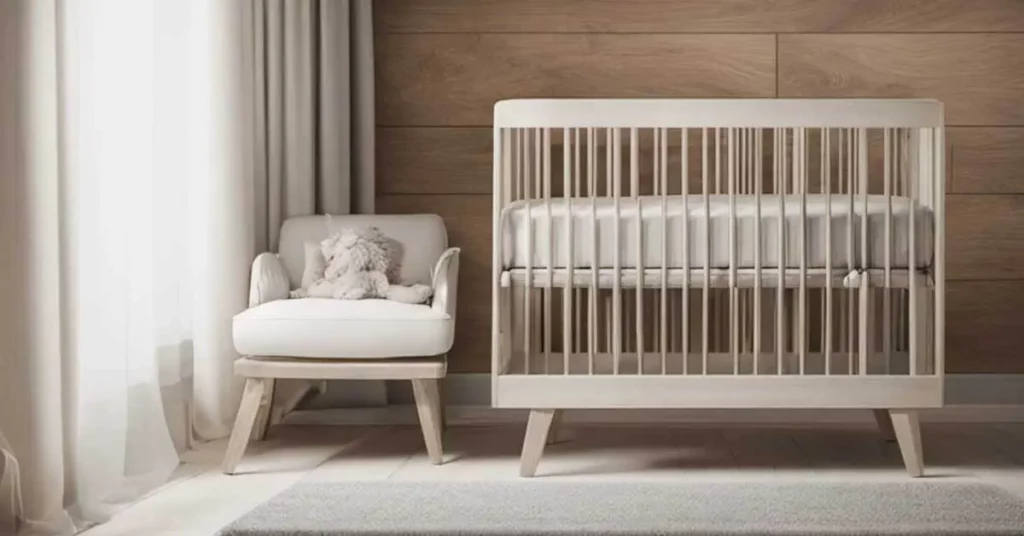
When preparing for a new baby, the costs of all the things you need can quickly add up. Unfortunately, one of the higher expenses is usually the crib. So, the temptation to purchase a second-hand baby crib to save money is understandable, especially when faced with the price tags of new modern cribs. But are second-hand baby cribs worth the risk?
Did you know that cribs are among the leading causes of nursery-product-related deaths, and used cribs often pose an even higher risk? I do not want to scare you. However, you shouldn’t overlook safety concerns regarding used cribs. Knowing them, you will know which second-hand cribs you should avoid and what to look for if you decide on one anyway.
Why is it Better to Avoid Second-Hand Baby Cribs?
All cribs sold today must meet rigorous safety standards set by the government. Understanding these standards is crucial! They are in place to prevent accidents that can lead to severe injuries or fatalities.
In the United States, cribs must meet safety standards set by the Consumer Product Safety Commission (CPSC). These include specifications on slat spacing, mattress support, structural integrity, and more.
I am not saying that a second-hand crib doesn’t meet safety standards. However, it is a high chance it does not comply with the updated regulations.
The latest regulation update was implemented in 2011, so avoid purchasing any crib manufactured before that year.
Another issue with second-hand cribs is their age.
Second-hand cribs may have been subjected to wear and tear, compromising their structure. Over time, materials can degrade and joints can loosen. A used crib may have dents and damage. There may be some missing parts, such as screws or bolts. All this can lead to an unsafe wobbling crib for your baby.
Additionally, older cribs (made before 2011) might be painted with lead-based paints or constructed from unsafe materials.
Should You Buy a Second-Hand Crib?
As you have already figured out, the most recommended decision is to buy a new crib. However, if you find a used crib that meets all the necessary safety criteria after careful inspection and consideration, you can go with it. Such a crib might be a good financial and environmental decision.
Just keep in mind that cribs, like all products, have a lifespan, which is around 10 years. So it is better to avoid all cribs older than that.
But how do you assess the condition of a second-hand crib?
Key Features and Checks Before Buying a Used Crib
We have gathered all the factors that you must carefully consider when deciding if a used crib is a good choice.
1. Identifying Recalls and Safety Alerts: Where to Check
First, check if the model has been subject to any recalls or safety alerts. The CPSC website provides a searchable database of recalls, making it easy to find this information.
A crib that has been recalled should not be used, regardless of its condition or price.
2. Inspecting the Crib While It Is Set Up:
One of the best ways to assess the condition of a second-hand baby crib is to inspect it while it is fully assembled. This allows you to check for stability and potential wobbling. If the crib is assembled, you can also ensure all parts are there.
Disassembled cribs can be difficult to evaluate and may be missing critical components.
3. Checking for Missing or Broken Parts and Sharp Edges:
Ensure there are no missing, loose, or broken parts. Also, look for any sharp edges that could harm your baby. Every component must be intact and in good working condition. Missing or damaged parts can make the crib unstable and unsafe.
4. Assessing the Crib’s Slat Spacing:
Crib slats should be spaced no more than 2 3/8 inches apart to prevent your baby’s head from getting stuck.
I also recommend you give the slats a firm shake to test their strength. Weak or widely spaced slats are a significant hazard.
5. Examining the Locking Mechanisms and Sturdiness of Portable Cribs:
Check the wheels’ locking mechanisms. They should engage securely and hold the crib in place without any movement.
If the crib is collapsible, check the locking mechanism that holds it upstanding. Sturdiness is key to preventing collapses that could injure your baby.
6. Compatibility with Modern Crib Mattresses
Ensure the used crib is compatible with modern crib mattresses and other safety accessories. The mattress should fit snugly within the crib, with no gaps larger than two fingers width between the mattress and crib sides.
7. Final Considerations
- Original Manual: It’s best to have the original assembly instructions. If these are not available, check if you can download them from the manufacturer’s website.
- Reputable Brands: Choose cribs from well-known, reputable brands known for their quality and safety standards.
- Price of Used Crib vs. New: Compare the cost of the used crib with new, budget-friendly options. Sometimes, the price difference may be small enough that purchasing a new crib is worth the added peace of mind.
The Balance Between Price and Quality in Second-Hand Cribs
While saving money is a primary motivation for buying second-hand, don’t compromise on quality. Sometimes, spending a little more on a new or certified refurbished crib can offer peace of mind and ensure your baby’s safety.
In conclusion, I know second-hand baby cribs can be tempting due to their lower cost, but the potential risks often outweigh the benefits. Thus, I can not stress enough: any used crib you are looking at must meet current safety standards, be free of recalls, and be in excellent condition.
